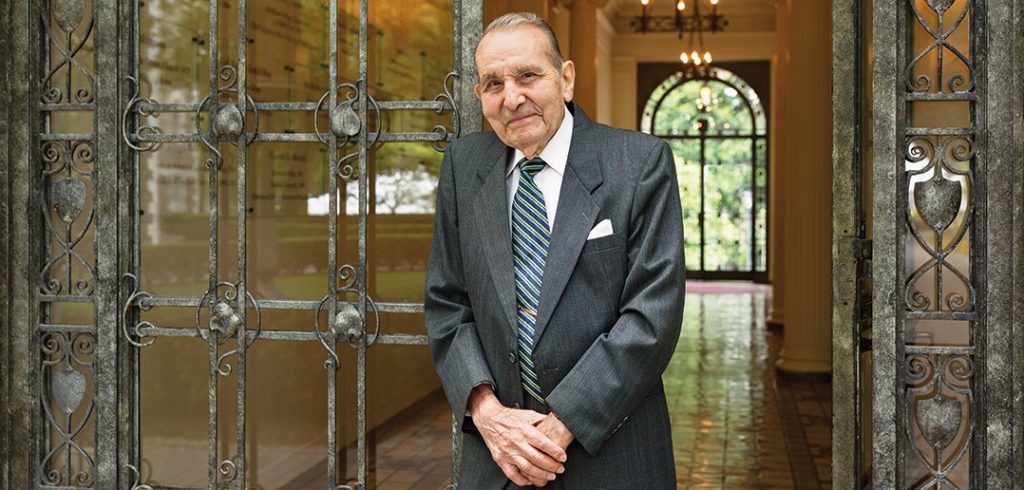Joseph Cammarosano, Ph.D., a Fordham professor emeritus and administrator whose tough and thoughtful leadership guided the University through some of its most pivotal moments, died on May 19 at South Nassau Community Hospital in Oceanside, New York, after suffering congestive heart failure. He was 97.
“Dr. C,” as students and colleagues knew him, served as a professor of economics, the University’s first faculty senate president, and an executive vice president during his 60-year-plus tenure.
“Joe was the beating heart of Fordham. He was supremely competent, tough-minded, and unfailingly kind and generous. He cared for the Fordham community deeply and was intensely loyal to the institution and its faculty, students, and staff,” said Joseph M. McShane, S.J., president of Fordham.
“Until the end, he was deeply involved in University life, and kept in touch with us as much as possible in his gentle but forceful way. We will all miss his sage advice and goodwill.”
Over many years and many leadership roles, Cammarosano contributed to major changes in the University’s finances, governance, and physical expansion.

He enrolled at Fordham as a freshman in 1941 and used to joke that he “only missed the first 100 years” of the University’s history. In 1975, on the occasion of his stepping down as executive vice president to return to teaching, James Finlay, S.J., then the University’s president, said, “If Fordham is alive and flourishing today, it is due to no one more than to Joe.”
Cammarosano was born on March 12, 1923, and raised in Mount Vernon, New York. Although he enrolled at Fordham in 1941, World War II interrupted his studies, and he served as a member of the Army Signal Corps until 1945, when he returned to Fordham. He graduated from Fordham College at Rose Hill in 1947 with a degree in economics and went to work as a U.S. customs inspector. After getting a master’s degree at NYU, he returned to Fordham, where he began teaching economics in 1955. He earned a doctorate from the Graduate School of Arts and Sciences in the subject in 1956.
Leadership During Turbulent Years
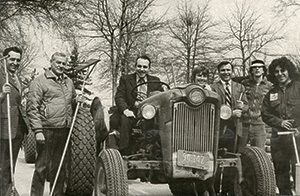
In 1961, he joined the Kennedy administration as an economist in the U.S. Bureau of the Budget, then moved on to the New York State Department of Taxation and Finance. When he returned to Fordham a few years later, he was elected as the first president of the newly formed faculty senate in 1965.
In 1968—a period of financial turmoil for the University—he was named executive vice president. He was one of the key figures in bringing Fordham back from the brink of bankruptcy. That year, the University was operating at $2 million deficit; by 1970, it had been transformed into a $2 million surplus, thanks in part to the advent of Bundy Aid (support for private colleges from New York state), the opening of what became Fordham College at Lincoln Center, and Cammarosano’s fiscal discipline.
Roger Wines, Ph.D., FCRH ’54, a professor emeritus of history at Fordham, served on Cammarosano’s budget committee at the time and worked with him as a member of the faculty senate.
“His committee … was told to cut the University budget 20% in three weeks,” Wines said at a 2015 dinner celebrating the 50th anniversary of the Faculty Senate. “He succeeded in meeting that goal, freezing salaries and hiring, slashing administrative costs and a number of positions. Not one classroom teacher was fired. Financial crisis was averted.”
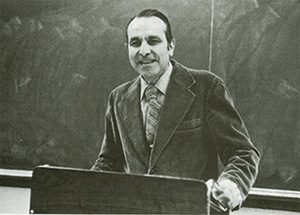
Wines said Cammarosano also played a central role in helping the University make the difficult transition from Jesuit oversight to governance by a board of trustees with several lay members.
“Joe played an effective central role, because he gained the trust of the faculty, of the Jesuit community, and the lay adviser members of the Board of Trustees,” he said.
“That trust was vital in guiding the University through the tumultuous years 1968 to 70, years when the University faced financial bankruptcy, student unrest, religious reform currents relating to the Vatican II Council, and protests against the Vietnam War.”
In an interview with Fordham Magazine in 2015, Cammarosano recalled how his office was occupied by students several times in 1969 and 1970 as protests against the Vietnam War roiled the country.
“The students took over the switchboard at one point, and when someone called for me, they said, ‘No, he’s no longer with us, we fired him.’ I almost wished they had fired me!” he said, laughing.
Monsignor Thomas J. Shelley, Ph.D., professor emeritus of theology and the author of Fordham: A History of the Jesuit University of New York: 1841–2003 (Fordham University Press, 2016), noted that Father Finlay was not engaging in hyperbole when he told the Jesuits’ Superior General, Father Pedro Arrupe, S.J., in 1975 that Cammarosano was “the person mainly responsible for the survival of the University.”
“At a time when we had so much trouble with finances and campus demonstrations, he was a rock of strength,” he said.
“I think it’s true that was the worst financial crisis the University ever experienced. It was a time when the South Bronx was burning, and it had made it up to Fordham Road, so that was another factor.”
A Dynamic Teacher with Boundless Energy
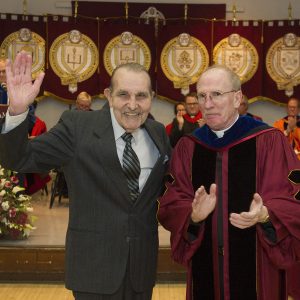
In 1976, Cammarosano was honored at the University’s faculty convocation as an “exacting taskmaster” who earned his students’ appreciation by preparing “meticulously” and lecturing “dynamically.” Cammarosano served as executive vice president twice; the second time was to assist the newly appointed president of the University, Joseph A. O’Hare, S.J., who took office in 1984. But he returned to teaching once again.
E. Gerald Corrigan, GSAS ’65, ’71, a managing director of Goldman Sachs and a former president of the Federal Reserve Bank of New York, studied with Cammarosano during the 1960s, helping him produce economic studies of the Bronx and the Brooklyn Navy Yard.
“He’s a dynamo,” Corrigan told Fordham Magazine, recalling how his mentor would deliver “two-hour lectures nonstop at a fevered pitch.”
In 2017, when Cammarosano—then in his 62nd year as a member of the faculty—received an honorary degree at the University’s 172nd Commencement, his citation noted “the personal attention that he gives his students in the classical Jesuit model of cura personalis.”
Dominick Salvatore, Ph.D., a distinguished professor of economics who first met Cammarosano when he joined the economics faculty in 1971, remembered him as a gentleman, scholar, and all-around wonderful human being.
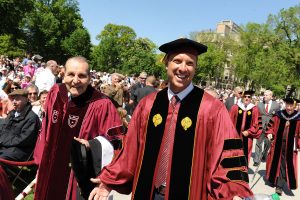
“The greatest compliment that students could pay to me was for them to tell me I reminded them of Joe Cammarosano,” he said.
“The students loved him and he was a rigorous teacher. He demanded things but was always jovial. I’m no young spring chicken myself, but very often I had to remind myself that I was talking to an over-90-year-old person because it was so easy to assume he was 65 or 70,” he said.
Mary Burke, Ph.D., a senior lecturer of economics, said that when one spoke to Cammarosano, he was so full of life and energy, one could be forgiven for assuming he’d be around forever.
“His office is next to mine, and every day he had classes, his office door would be open. He would be there until 5, 6, or 7 p.m. As long as there was a student who wanted to ask a question or just talk, he would be there for them,” she said, noting that conversations related to the Yankees could go on especially long.
“I met Dr. Cammarosano when I was a student. Now, I have known him as a mentor, advisor, and a dear friend.”
Cammarosano continued to teach well after many peers had retired, most recently in the fall of 2018. He submitted his formal letter of retirement in February. Matthew McCrane, GABELLI ’19, took Introduction to Macroeconomics with him, and recalled the boundless energy that belied his age.
“It was a privilege to have been taught by someone who has taught so many alumni before me. It was like I was experiencing a staple part of Fordham. In a way, it’s like I can connect with much older alumni as a result of having had him in class,” he said.
Making a Mark as an Administrator

Stephie Mukherjee, assistant dean and director of Fordham’s Higher Education Opportunity Program at Rose Hill (HEOP), called Cammarosano a “giant” and “Father of Fordham” for his outsized influence on the University. He was responsible for bringing HEOP to Fordham when the state program was created in 1969, and on numerous occasions, he stepped in to save it when funding was threatened, she said.
“He believed in the students, he believed in the underprivileged, he believed in people, and I’m grateful that he believed in me. He knew that this job is my passion, it’s not just a job,” she said.
“He was such a kindhearted, warm, wonderful person. He touched so many people’s lives.”
Sheldon Marcus, Ed.D., professor of educational leadership at the Graduate School of Education (GSE), recalls trying to get funds approved by Cammarosano in the 1970s to reimburse an administrator for weekend hours spent working. The paperwork for the request came back with Cammarosano’s bold script: “Rejected.”
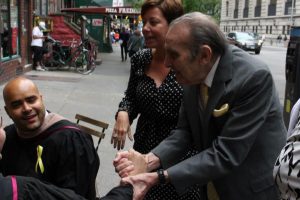
When he went to see Cammarosano in his office, Marcus was greeted with more colorful language that seemed to indicate his case was lost. But then Cammarosano asked for the papers back, scratched out “rejected,” and added, “approved.”
Marcus said he started to leave, “happy to walk out of his office with my head still on.” But Cammarosano said, “Wait a minute.” He put his arm around Marcus and said, “Shelly, you’ve been working too hard, go home this weekend and don’t do another thing; get some rest.”
“He was just the most humane guy behind that tough rough exterior,” said Marcus. “It has been a pleasure to be at Fordham because of people like him; he just made it family.”
Family Above All
Cammarosano’s daughter Nancy Hartzband, FCRH ’77, LAW ’83, said her father was very connected to his own family, including his five grandchildren.
“I think it was such a good relationship because he dealt with young people his whole life, which he loved. He knew them one on one, he guided them, he was a very important figure in each of their lives,” she said.
“He set the bar really high for all of us in terms of morals. Whenever I’m in doubt, I ask, ‘What would my dad do?”
She too marveled at his stamina, noting that two years ago he published An Overview of the Development of Economic Thought (Lexington Books, 2018), the last of his three books about the ideas of economist John Maynard Kenyes.
“I mean, who does that? At that age, I’ll be happy to be sitting in my rocking chair,” she said laughing.
“But that was him. He always wanted to learn, he always wanted to do something new.”
Cammarosano still had an apartment in his native Mount Vernon, she said, but had recently moved in with his son in Island Park, New York.
She said her father was a devout Catholic who maintained his connection to Fordham for eight decades because he believed strongly in its Jesuit mission.
“We always knew we were very special because of the person he was at the University,” she said.
“He was just an incredible presence in our lives. He was almost larger than life.”
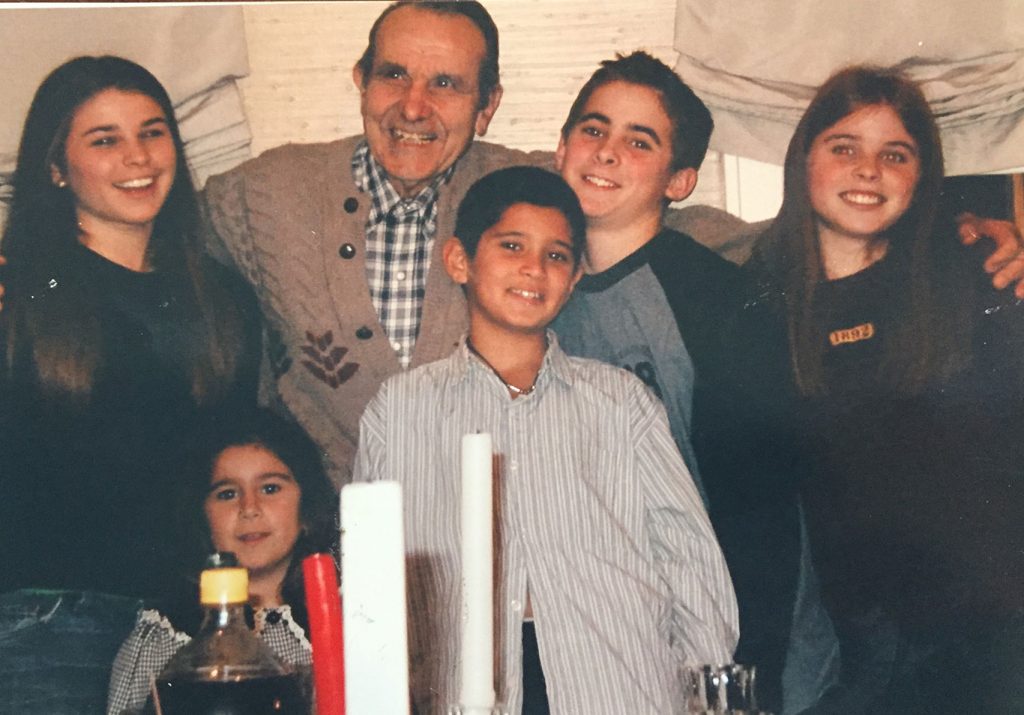
“I think it was such a good relationship because he dealt with young people his whole life, which he loved.,” said his daughter, Nancy. Photo courtesy of Nancy Hartzband
Cammarosano is survived by Hartzband and her three children as well as his son, Joseph R. Cammarosano, FCRH ’78, LAW ’81, Joseph’s wife, Mary, and their two children. Two of his grandchildren are alumni as well: Danielle Cammarosano, GABELLI ’19, and Alex Hartzband, LAW ’15. Cammarosano’s wife, Rosalie, died in 1991 and his son Louis T. Cammarosano, FCRH ’74, LAW ’78, died in 2014.
He was interred at the Gate of Heaven Cemetery in Hawthorne, New York, after a private funeral service. The University will also hold a memorial mass in his honor at a date in the future.
To hear Cammarosano talk about working and living in the Bronx over the years, listen to his interview with the Bronx Italian American History Initiative.
—Tom Stoeker contributed reporting.

